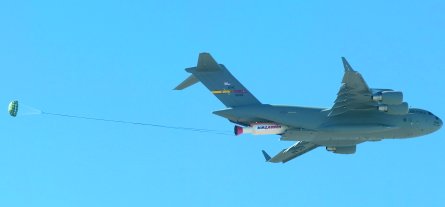Graham Warwick in Washington DC
|
| The QuickReach launch vehicle will be the heaviest payload dropped from a USAF Boeing C-17 transport |
The US Air Force plans a suborbital test of a reusable vehicle as part of efforts to develop a quick-reaction launch capability for satellites. The test would involve a quarter-scale demonstrator of the first stage of a hybrid launch vehicle (HLV).
Four companies have been awarded contracts to study the two-stage reusable/expendable HLV, but an open competition is planned for the demonstrator, says Col Jim Painter, director of development planning for the USAF Space & Missile Systems Center. A request for proposals for the demonstrator could be released by early next year, he says.
Andrews Space, Lockheed Martin, Northrop Grumman and Orbital Sciences have been awarded 14-month study and analysis contracts to define architectures for a 2020-timeframe HLV able to launch 6,800kg (15,000lb) payloads with a 48h turn-around between flights (Flight International, 16-22 May). Launch costs are expected to be reduced by two-thirds over expendable launch vehicles, says Painter.
After taking off vertically, the rocket-powered reusable first stage would fly to 200,000ft (61,000m) and Mach 7 to release the expendable upper stage, which would boost the payload into orbit. The first stage would then return autonomously under rocket or jet engine power to a runway landing at the launch location.
Compared with fully reusable single-stage-to-orbit launch vehicles, the partially reusable, two-stage HLV reduces the mass that must be orbited and avoids the need for exotic materials to withstand re-entry.
The USAF is seeking $19 million in fiscal year 2007 for the subscale demonstrator, with the goal of flying to M7 and 200,000ft and returning autonomously to the launch location, Painter says.
Painter says the HLV is one of several “operationally responsive” spacelift concepts being analysed.
Source: Flight International
























